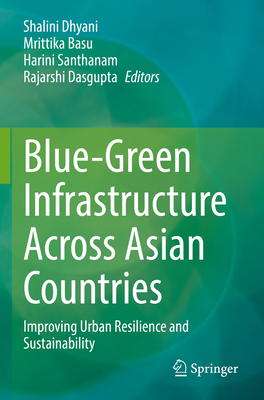图书简介
This edited book discusses Blue-Green Infrastructure (BGI) from conception to implementation in building resilience and urban sustainability. The book emphasizes on infrastructures, institutions, and perceptions as three main pillars of implementing and managing successful BGI, with a special focus on Asia. The book highlights concepts as well as field-based experiences from different parts of Asia by experts, with a special focus on advances and opportunities in advancing BGI, challenges and constraints, followed by case studies on BGI mainstreaming. It addresses sustainable water management, multiscale environmental design, environmental risk assessment, and finally understanding policy implications and concerns for BGI mainstreaming in growing urban sprawls of the region. There has been growing global momentum and recognition of Blue-Green Infrastructure (BGI) as a multifunctional Nature-based Solution (NbS) with multiple co-benefits. There is strong evidence from many urban centres of Europe, USA, China, and South Africa demonstrating that mainstreaming BGI can help in addressing growing vulnerability of urban areas by ensuring safety, resilience, and sustainability for urban residents in the warming world. This book is a timely contribution for researchers, students, scholars, urban planners, consultants, and policy makers in the fields of environment, resilience, urban planning, climate adaptation, and sustainability science.
Chapter 1. Mainstreaming Blue-Green Infrastructure for improving urban resilience and sustainability in the warming world.- Chapter 2. Regional trends in Social-Ecological Technological (SET) approaches to Sustainable Urban Planning: Focus on Asia.- Chapter 3. A Risk Assessment Approach to Urban Resilience .- Chapter 4. Promoting Blue Green Infrastructure in Urban Spaces through Citizen Science initiatives.- Chapter 5. Is Ensuring the Sustainable Implementation of BGI Possible? System Thinking of Urban Rivers as Social-Ecological Systems.- Chapter 6. Understanding Blue-Green Infrastructure through Spatial Maps: Contribution of Remote Sensing and GIS Technology.- Chapter 7. Cities and Biodiversity: Hidden Connections Between the Built Form and Life.- Chapter 8. Assessing ecological risks of urban air and water environment to analyse the scenarios for mainstreaming Nature-based Solutions: a case study of Bengaluru city, India.- Chapter 9. Do people appreciate economic value of water in Baku city of Azerbaijan?.- Chapter 10. Homegardens as sustainable urban agroforestry systems to promote household well-being in Kandy, Sri Lanka.- Chapter 11. Opportunities for Improving Urban Tree Cover - A Case Study in Kochi.- Chapter 12. Changing people-nature linkages around green infrastructure in rapidly urbanizing landscapes: the case of a protected area in Bengaluru Metropolitan Region of South India.- Chapter 13. Remodelling Urban Spaces in the Light of Blue-Green Infrastructure: A Case Study of Guwahati, India.- Chapter 14. Nature-based Solutions for the Restoration of the Abukuma River Ba-sin (Japan) after Typhoon Hagibis.- Chapter 15. Nature based solutions (NbS) for sustainable development of the resource-base and ecosystem services of marine and coastal ecosystems of India.- Chapter 16. Physical Vulnerability Assessment to Flooding of Residential Houses along the Coastal Areas in Sta. Rosa City, Laguna, Philippines.- Chapter 17. The significance of ancient water systems and the sacred groves in the landscape of Badami, Karnataka - A geospatial study.- Chapter 18. Urban Sustainability and Resilience building: Blue-Green infrastructure for air pollution abatement and realising multiple co-benefits.- Chapter 19. Disaster Risks and Resilience of Urban Bangladesh: Role of Blue Green Infrastructure.- Chapter 20. Endorsing City Biodiversity Index (CBI): Assessing Ecosystem Health in urban sprawls and Eco-DRR inclusive urban planning.- Chapter 21. Greenhouse Gas Mitigation by Integrating Waste Treatment System towards Low-Carbon City in Vietnam.- Chapter 22. The roles of non-governmental actors in facilitating urban blue-green infrastructures: A comparative review of the community initiatives in Taipei City, Taiwan.- Chapter 23. Mainstreaming blue-green infrastructure in policy and planning for urban resilience in the global south: promises and pitfalls.
Trade Policy 买家须知
- 关于产品:
- ● 正版保障:本网站隶属于中国国际图书贸易集团公司,确保所有图书都是100%正版。
- ● 环保纸张:进口图书大多使用的都是环保轻型张,颜色偏黄,重量比较轻。
- ● 毛边版:即书翻页的地方,故意做成了参差不齐的样子,一般为精装版,更具收藏价值。
关于退换货:- 由于预订产品的特殊性,采购订单正式发订后,买方不得无故取消全部或部分产品的订购。
- 由于进口图书的特殊性,发生以下情况的,请直接拒收货物,由快递返回:
- ● 外包装破损/发错货/少发货/图书外观破损/图书配件不全(例如:光盘等)
并请在工作日通过电话400-008-1110联系我们。
- 签收后,如发生以下情况,请在签收后的5个工作日内联系客服办理退换货:
- ● 缺页/错页/错印/脱线
关于发货时间:- 一般情况下:
- ●【现货】 下单后48小时内由北京(库房)发出快递。
- ●【预订】【预售】下单后国外发货,到货时间预计5-8周左右,店铺默认中通快递,如需顺丰快递邮费到付。
- ● 需要开具发票的客户,发货时间可能在上述基础上再延后1-2个工作日(紧急发票需求,请联系010-68433105/3213);
- ● 如遇其他特殊原因,对发货时间有影响的,我们会第一时间在网站公告,敬请留意。
关于到货时间:- 由于进口图书入境入库后,都是委托第三方快递发货,所以我们只能保证在规定时间内发出,但无法为您保证确切的到货时间。
- ● 主要城市一般2-4天
- ● 偏远地区一般4-7天
关于接听咨询电话的时间:- 010-68433105/3213正常接听咨询电话的时间为:周一至周五上午8:30~下午5:00,周六、日及法定节假日休息,将无法接听来电,敬请谅解。
- 其它时间您也可以通过邮件联系我们:customer@readgo.cn,工作日会优先处理。
关于快递:- ● 已付款订单:主要由中通、宅急送负责派送,订单进度查询请拨打010-68433105/3213。
本书暂无推荐
本书暂无推荐
















